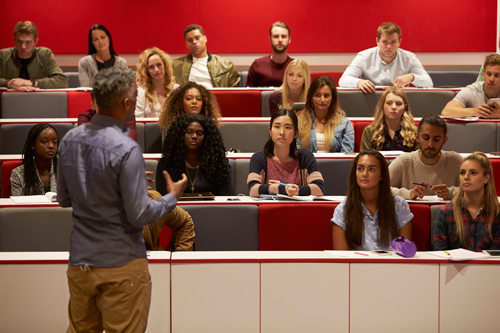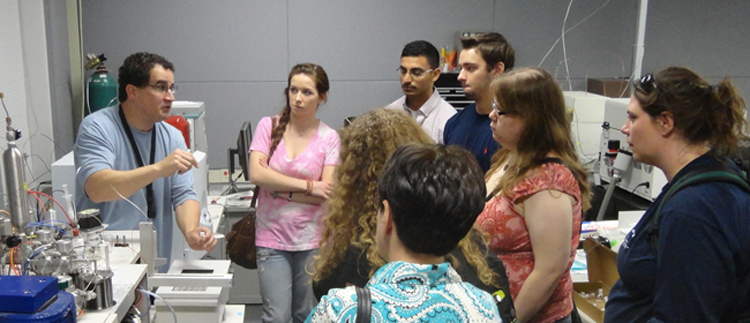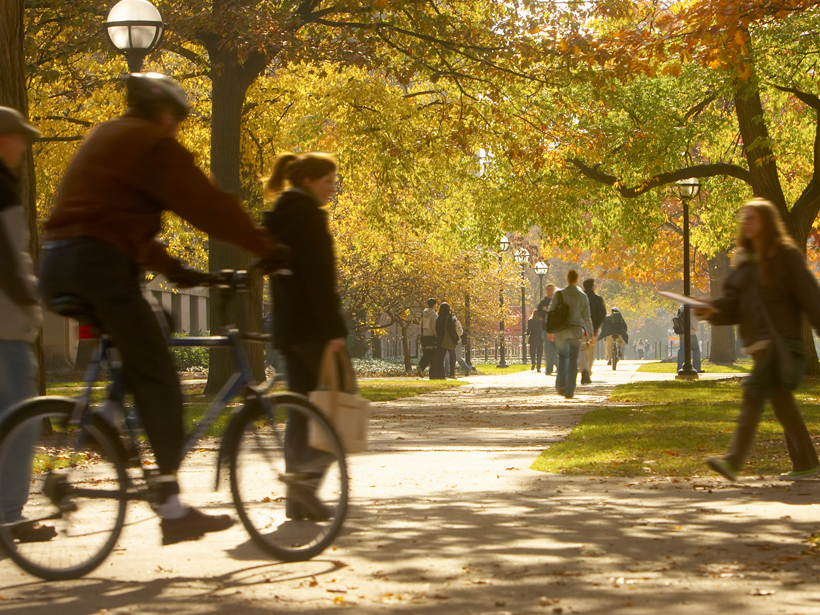As autumn approaches, colleges are sprucing up, getting their campuses ready for the return of students from summer vacation. Many professors, however, have remained hard at work through the summer months, gearing up for the time when classes resume in the fall.
Summer’s lack of classes and rigid teaching schedules gives professors the freedom to accomplish tasks that may have taken a backseat during the fast-paced academic year. Job responsibilities like writing research papers and funding proposals, conducting fieldwork, and taking a more hands-on supervising role for student researchers often take center stage for professors during the summer months. Similarly, of course, planning for the courses they will be teaching again in the fall moves front and center.
So how do college teachers and researchers make the most of their work time during the summer and prepare effectively for the fall semester? In June, Eos reached out to a small group of geoscience professors from varied disciplines, types of schools, and nationalities to find out. Their professional experiences focus on teaching, research, and public engagement in science at colleges across the United States and beyond.
Adriana Perez (AP) is an associate professor at El Paso Community College and a lecturer at the University of Texas at El Paso. Her job focuses exclusively on course instruction, and she will be teaching two Earth science courses and a class in physical and historical geology this fall.
Derrick Lampkin (DL) works at the University of Maryland in College Park. He is an assistant professor in the Department of Atmospheric and Oceanic Sciences, an adjunct professor in the Department of Geology, and an affiliate of the Earth System Science Interdisciplinary Center (ESSIC). This fall, Lampkin will be teaching a graduate-level course on the cryosphere. He also mentors three graduate students and one undergraduate student and investigates ice sheet system responses to changing regional climate in Greenland and Antarctica.
Laura Guertin (LG), professor of Earth science at Penn State Brandywine in Media, will be teaching an introductory-level Earth science course for nonscience majors that focuses on big ideas and supporting concepts of Earth science. This summer, Guertin will be supervising undergraduate students in a project that addresses climate science communication among college audiences and another that aims to increase campus and community collaboration on sustainability-themed projects. She also writes the GeoEd Trek blog on the AGU Blogosphere.
Nisia Krusche (NK) is a professor at the Computer Sciences Center in Universidade Federal do Rio Grande in Brazil and currently researches the contribution of atmospheric turbulence to wind power. She supervises four full-time graduate students as well as graduate and undergraduate exchange students and teaches two graduate-level courses in the spring semester.
Eos asked each of these professors to describe how they plan their summer activities to best prepare for the fall semester. Their advice can guide new professors figuring out how to make the most of their summer work time or give experienced professors new ideas for revamping their teaching or mentoring style. Their responses have been edited for clarity and brevity.
Writing, Planning, and Collaborative Research
Eos: What job-related activities are you doing this summer (e.g., research, working with students, lab work, fieldwork, travel, proposal/grant writing or reviewing, supervising thesis defense, etc.)?
I’m always looking to keep the content current and for new and innovative ways to actively engage students in their learning.
LG: Just about all of the above! I’m working on writing book chapters this summer. I can get the most writing done during the summer months, when I have the time to focus and not have to worry about the demands of teaching. I am working with students and other faculty this summer on a sustainability grant from my institution.
I am also revising the Earth science course I’m going to teach this fall. Although I’ve taught the course several times, I’m always looking to keep the content current and for new and innovative ways to actively engage students in their learning, to help them learn the currency of the field, apply what they learn, and reflect upon “why Earth science matters” in their lives now and in the future.
DL: In general, my summers are occupied with activities that include writing, submitting, and editing research papers, writing proposals or funding grants, conducting fieldwork, supervising thesis defenses, or traveling to conferences or meetings. Each summer can be different. This summer I am largely occupied with writing and submitting research papers and funding proposals. I am also engaged in planning meetings with colleagues to establish collaborations for future papers or proposals.
NK: I am teaching in the spring, so my prep time is during the winter months. During the past winter, I worked with my students on writing research papers and supervised one dissertation.
AP: I teach year-round, so I have limited additional activities during the summer. I recently attended the [Earth] Educators’ Rendezvous in Albuquerque, N.M. [an annual workshop for education researchers and teachers of undergraduate Earth science], and I volunteer for field trips and other college outreach activities.
Plan Ahead and Keep Courses Fresh
Eos: What are the most successful things you have done to get ready to teach a class in the fall and that you would recommend to your colleagues, especially first-time teachers?
NK: The most successful thing I’ve done is thoroughly planning my classes. In more recent years, we keep our notes on an open-source course management system, so I make sure to update everything from past versions of the course. It is a very good idea to complete this before classes start.

LG: Write a detailed syllabus—the more information you provide students, the more comfortable they are starting your course. List your course goals and learning outcomes on the syllabus, so students know the expectations. Make sure the course topics, exercises, assignments, and projects tie back into those goals and outcomes. Know where you are going throughout the semester, not just for the first week. The more planning you can do before the semester starts, the tighter and more organized your course will be.
AP: You do need to have a game plan. Summer is a great time to look for new activities, methodologies, tools, databases, and software that you might want to try in the classroom. I teach a lot of online sections, so I do try to have the class “skeleton” ready by the start of the semester. I will add materials as the semester starts and progresses, but I do need to make sure the main sections are ready to go from the start.
DL: I would suggest spending time considering creative ways to connect to students. These efforts are not always successful but can sometimes be fruitful. I think multimodel courses that have pathways for engaging students through multiple kinds of exercises keep students largely engaged and interested.
Eos: What are the least successful things you have done to get ready to teach a class or facilitate student research and that you would caution your colleagues to avoid doing?
There will be things that you cannot plan for until the activity is field-tested, but the more you have tested ahead of time, the smoother it will go. Always have a Plan B.
AP: One of the biggest mistakes is not trying out an activity first before trying it in the classroom. Make sure databases, downloads, software, etc., work before you use them in a class. There will be things that you cannot plan for until the activity is field-tested, but the more you have tested ahead of time, the smoother it will go. Always have a Plan B. There is always a chance of technical difficulties, missing students, or materials not being available, but if you are flexible, you can work on something else.
DL: Do not let years pass without updating your course content. I think this can happen often and for certainly benign reasons. Many of us get very busy, and if a course is already set up, we really like to let it run on autopilot. This can work for a couple seasons, but students eventually catch up to you and realize that your course is antiquated. They can be very vocal about this in the student evaluations and are quite displeased.
LG: If you are going to use educational technology, always test it out first! I tap into our instructional design specialist on campus to help me develop, design, and do trial runs with any new technology I use. We test the different settings and use different computer platforms and browsers to see what students may view, what plug-ins may be needed, etc. So my advice is to not use technology blindly and assume it is going to work perfectly for you or for students!
Eos: Is there anything that you always make sure to do to get ready for the fall semester?
DL: I revise my course lecture materials to reflect recent changes and discoveries in the discipline and consider new ways of updating course activities in response to student input via the end-of-semester student surveys.
NK: I need to have a good plan for the semester. I get the academic calendar, and for each class I plan the distribution of material over the course of the semester.
AP: I plan out the entire semester week by week, with about one topic per week. If I have this set from the beginning of the semester, it helps me keep on schedule and helps me to plan ahead as well. If there are certain sections that I want to improve, it helps to know how much prep time I will have available once the semester starts. This road map is extremely helpful to have once all the additional activities (e.g., meetings, workshops, conferences, office hours, etc.) are happening.
LG: Since I always seem to have at least one day of canceled classes due to snow, I have now a “snow day” online activity in my back pocket. Having an emergency snow day lesson ready to go helps me continue with my planned in-class activities while also not having to worry about frantically pulling together a meaningful online lesson for students to complete. So for faculty that live in regions that may face school closures due to weather, be prepared for how you will make up the instructional time!
Research Can Rejuvenate Course Material

Eos: If you’re doing research this summer, how do you use the results of that work in your ongoing research, teaching, or student mentoring tasks in the fall?
NK: My research advisees all work with the data we collect during the summer throughout the year. I usually do not use those data in class because there is no relationship between those topics and my research.
DL: We, my colleagues and I, are eager to talk about our work. It invariably finds its way into our lectures even without any formal planning. I like to mix results from my research and personal stories and experiences as a glaciologist into the lectures. The combination of wonder, physical challenges, and human drama that results from putting complicated personalities in a challenging and virtually alien environment makes for very compelling and humorous stories. These stories contain small lessons on science and life in general.
Eos: What research tasks do you take care of or earmark for the summertime specifically to help get ready for the fall semester?
LG: I try to complete as much of my research as I can in the summer, especially any writing of grant proposals and/or journal articles. I have a high teaching and service load at my university, so I make sure my research gets the time it needs and deserves in the summer months. Then I can devote time to my students and teaching once the semester begins.
DL: I like to sequester time to consider where the current state of knowledge is relevant to the intended course content for the following semester. I also teach courses in the spring semester, so I make this consideration again during winter breaks. This effort involves reviewing journals and science magazine outlets that showcase exciting work published in peer-reviewed literature.
Eos: If you mentor undergraduate, graduate, or postdoctoral researchers in the summer, how do the student projects help you prepare for the fall, or how do those research projects transition into the fall semester?

DL: Not all research directly translates into the classroom. The business of science is complicated, and the process is iterative and nonlinear. Projects can be in any phase of the scientific process: hypothesis, data acquisition, analysis and results, or going back and revising the original hypothesis. So it is not always appropriate to communicate project findings to students if things are not clear. Sometimes these events and setbacks are teachable moments, and I will often use our failures directly in lectures to demonstrate what the process of real science looks like.
Discussions I have with my students about their projects might help to put some new topic into the classes I am teaching.
NK: Some of the discussions I have with my students about their projects might help to put some new topic into the classes I am teaching.
LG: The work I, fellow faculty, and students are doing on the Penn State Sustainability Institute’s grant is going to seamlessly continue into the fall semester. As we are working with community partners for this grant, community organizations do not operate on a semester system like we do in higher education. Their needs and efforts continue year-round, and our work to collaborate with and to support them must also be throughout the year.
Plan, Innovate, Engage
Whether it’s content, location, or students, each semester presents a new set of challenges that a professor needs to meet. Our respondents consistently suggest that detailed planning of your semester ahead of time, regularly updating your course content and approach, and bringing real research into the classroom can improve your teaching and research experiences and help your students learn. These few key pieces of advice can help make your fall semester, whether your first or your fiftieth, a success.
Eos extends its thanks to Adriana Perez, Derrick Lampkin, Laura Guertin, and Nisia Krusche for taking time out of their busy summers to answer our questions and share their experiences with our readers.
—Kimberly M. S. Cartier (@AstroKimCartier), News Writing and Production Intern
Citation:
Cartier, K. M. S. (2017), Gearing up for fall semester, Eos, 98, https://doi.org/10.1029/2017EO079635. Published on 14 August 2017.
Text © 2017. The authors. CC BY-NC-ND 3.0
Except where otherwise noted, images are subject to copyright. Any reuse without express permission from the copyright owner is prohibited.

